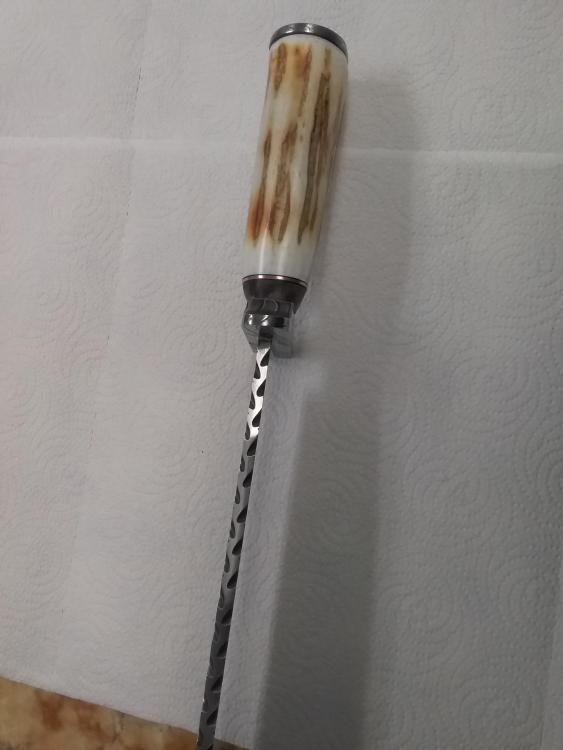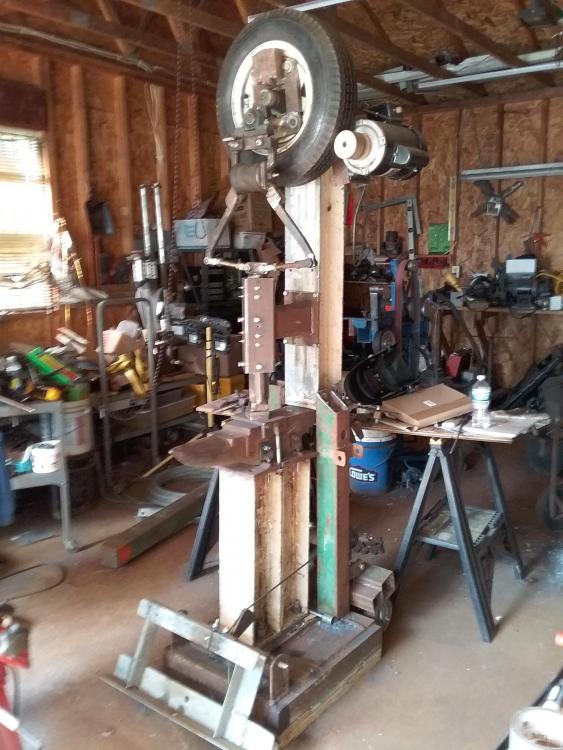
Buzzkill
-
Posts
2,065 -
Joined
-
Last visited
Content Type
Profiles
Forums
Articles
Gallery
Downloads
Events
Posts posted by Buzzkill
-
-
On 9/12/2021 at 9:55 PM, templehound said:
It is fascinating how thin on the edge and how different hard his blades were...there must be some manual skills how accurate in angle and speed the blade is driven into a chunk!(not a nail!) of steel....he never gave up his secret until he died
I read an article about him a few years ago which contained less technical information, but more or less the same story. What was interesting is one of the commenters on the article claimed to have been a child in the town where and when Richtig was making his knives. According to this person one of the things Richtig did was tap each blade against something and listen to the resulting sound. If he didn't like the sound he tossed it in the scrap pile, and if he did like it he would finish the knife. Of course I have no way of knowing if any of that is true, but it is entirely possible that he did have quite inconsistent heat treating but also used sound to weed out those that would not perform well.
-
What I did where the "dome" meets the floor on my D shaped forge is use a couple strips of fiber blanket which were sprayed with rigidizer to make a gasket of sorts. This makes removal of the top portion easy when needed but also provides a "flame tight" connection between the two slightly irregular surfaces.
-
1 hour ago, Dax Hewitt said:
catching covid with little to no symptoms
This is what makes it tough. The result of infection with the virus ranges from no symptoms at all to death. That's pretty much the maximum range possible. It's like viral Russian roulette. I tested positive and had relatively mild symptoms last December. Others my age in my area have perished from the virus. For me this is no different than any number of other safety related issues. Each person should assess their personal risk based on the information available and protect themselves and those around them accordingly.
However, you cannot use logic to help someone out of a position they didn't use logic to get into in the first place.
-
If you have any kind of grinder (bench, angle, belt, etc) and a reasonably steady hand I'd recommend grinding 3/4 or more of the cutting edge in and then finish with the stones. You'll wear out your arms and your stones removing that much metal that way.
If you have no grinder then you may want to try some low grit sandpaper with a backing board and your jig to get the cutting edge close to where you want it to be.
And BTW, I agree with your kids. Looks good.
-
-
TP - Granted, but the question was really whether a single 1 inch layer of insboard would suffice.
-
Not sure that helps with his situation.
I've only used fiber board on a very limited basis. However, it did seem to me that the insulating properties are impressive. I had a piece glowing on one side with my hand comfortably on the other side from where it was glowing. That was an inch thick piece, so you are probably ok with a single 1 inch piece. If you want extra peace of mind you could add a second layer, but I doubt it's necessary.
-
I rarely do false edges on the spine, but when I do they are less than half the length of the spine and I grind them after the bevel for the cutting edge. I have no particular reason why. It's just the way I do it and any way that safely gives you the result you want is the right way.
Your bevel in the picture above looks pretty darn good to me. I like that you gave yourself a lot of options for changing the bevel angle slightly in your jig. Well done IMHO.
-
On 8/28/2021 at 4:02 PM, anvil said:
My experience says different. Besides space saving, A tank-less system is pretty much all copper tubing whilst a hot water tank is cast steel or iron. Copper doesn't rust out.
Oh there are some definite benefits. I like it hanging on the wall rather than taking up space next to the furnace and water softener. It's also really quiet. I had my doubts about the claim of 93% efficiency, but the exhaust coming out of the system is barely warmer than ambient and exits the house via PVC pipe. I'm not sorry I did it. I just really didn't know what I was getting into as far as the extra expense and labor goes. If I was building a new house I'd probably spec it out with a tankless water heater to begin with.
In the negative column it does take about 15 to 30 seconds longer for hot water to get to the top floor of the house, and of course if the power goes out there is no stored hot water unlike the tank.
However, not having to be concerned with 3 people taking a shower before you using all the hot water is a definite benefit.
-
Yeah, but in extreme cold temperatures hot water freezes faster than cold water, although that's not really relevant.
FWIW, I installed a propane tankless water heater in the house a couple months ago. It probably uses a little less than the previous tank version, but the up front cost is a lot more and I had to make modifications to the gas, electric, and water lines in the house. Knowing what I know now I probably would have gone with another tank version, but on the bright side the tankless unit should last about twice as long.
-
I believe it was a typo that was intended to be "plotting."
-
As everyone else has indicated, handle size and shape is influenced heavily by the intended use and the person who will be using the tool/weapon. When in doubt, always start bigger/thicker. You can remove material much easier than adding it. For me the two biggest questions in handle shape are 1) Does it feel comfortable and secure in my hand when holding it how I would use it?, and 2) with my eyes closed can I tell where the cutting edge is just by holding the handle?
Generally speaking, handles that feature swells both in width and on the cutting edge side of the handle make a big difference in the comfort and secure grip on a handle. Of course those have to be placed and spaced correctly on the handle, but it doesn't take much trial and error to get a feel for that.
-
For a hollow grind you'll want a much bigger wheel than you've been trying to use. Something 2" in diameter or smaller is more suited to grinding in fullers than hollow grinding the bevel on a blade. I use an 8 inch wheel for that frequently, but I think 10 to 14 inch would be better for blades 1.5" or more from spine to cutting edge.
-
-
Right. The point is you don't want moisture pulled away from the kastolite.
-
You didn't mention the material of your mold form. In my experience anything that can wick moisture away from the kastolite when you apply it can result in a "crumbly" casting. Any surface in direct contact with the kastolite should be damp/wet first.
-
If you're fairly certain you have the alignment correct then you can solder the mig tip to the brass fitting.
-
I think you are on the right track with the bushings/shafts. You're describing something similar to what I experienced a few years ago. I ended up taking mine apart, polishing the shafts, cleaning out the bushing holes well, and applying some grease. That stopped the "grinding" noise for a while. I think what was happening in my case is that the bushings were worn enough to allow the shaft(s) to move back and forth inside the bushing just a little, but rapidly. I don't believe it was grinding in the sense of the teeth wearing on another surface, just slop that translated to a noise and resistance. Your situation may be different.
-
I believe that Thomas Powers has reported good contrast between bandsaw blades and pallet strapping. I'm not sure which is the light and which is the dark. Maybe he'll chime in here.
-
New tools!
in Lathes
I'm still not sure how that gets you more than 24 hours in a day. I lived in Fairbanks, AK for a couple years and we did have 23 hours of daylight in the middle of summer without ever going completely dark before the sun came up again, but our days were still 24 hours long if I recall correctly.
-
More than half, but yes. I got it from someone who was using it as a yard decoration. It's a HB, and appears to have broken at the waist. It's a clean break though, so it's always made me wonder if someone did machine work on it or if it was made that way intentionally. It has 2 3/8" holes bored completely through the body. The spacing, placement, and precision of the holes makes me think it could have been manufactured that way, but it could also be the result of a skilled machinist with the right tools later on.
-
New tools!
in Lathes
6 minutes ago, Frosty said:We get not quite 29 hours/day at this latitude.
Are you sure you live on the same planet as the rest of us?
-
-
Sounds like you have the right idea. If you make believers out of them when they are young it will significantly decrease the frequency and severity of the discipline you have to administer as they get older.


The Andaman Swipe
in Knife Making
Posted
I found the article and the comment. Here's a portion of the comment:
"I can add a little to the Richtig story. As a young boy for a number of years during world war two he was in need of aluminum to make his knives. My dad had quite a few pistons from doing overhaul jobs on cars and tractors and when my Red Ryder wagon got full I would take them to Frank. Many times when I took them there he was tempering blades. In the process he took them off the forge and dipped the blade in a solution in a bucket, I don’t know what the solution was or how long he kept them in it, but after they cooled he would hit the blade on an anvil with one hand and with other he would hit a tuning fork. If the tone was the same the blade went into the good blade bucket, if not it went to the forge later."
And here's the article:
https://clarksonhistory.wordpress.com/2013/05/06/secrets-of-the-dead-the-richtig-knife/